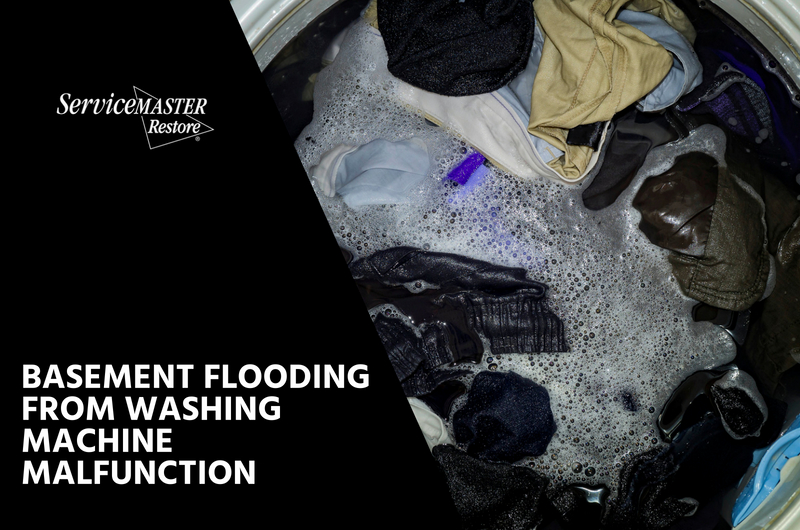There are many home appliances that we rely on regularly; but when you have a washing machine leak, it can cause major basement flooding problems that can be long-lasting if not treated quickly. Besides the obvious problem of needing to fix the washer, there are other things to consider.
Older washing machines can use between 10-30 gallons for every load washed. High-efficiency washers use less water, but there is still a risk of lots of water pouring onto your floor if there is a malfunction.
A first-floor or second-floor laundry room has its conveniences, but also some risks if there is a water leak. Water seepage down through the floor to the ceiling below can cause extensive water damage. When the laundry room is in the basement, there are also damage and contamination problems to be aware of. Either location brings the risk of increased bacteria and mold growth after a water leak.
Why do washing machines malfunction?
Water moves through the supply lines on the machine at a high pressure. Sometimes, this can cause a weak spot in the hose, especially if it is rubbing against other parts during the vibration of the various cycles. Check the hose for bulging or soft areas, which might indicate a weakness.
Sometimes, the hose becomes loose at the connection point, indicated by water dripping or spraying at the connection. A blocked hose mesh screen or cracked O-rings inside the connection may also cause a leak.
Another area of malfunction involves the drain pump of the washer. Deterioration, rust, or cracks will allow for water seepage, especially if the drain pump cannot extract water properly. Weak areas to check around the drain system of the washer include the drain hose connector and the seal. The drain hose can become blocked with debris, just like the supply hose at the start of the system. Check for proper drainage and hose integrity to eliminate leaks.
Rubber parts inside the machine can eventually wear down. Top-loading washers have a tub gasket, which can have cracks or rotten areas, eventually causing small leaks. Front-loading washers have a strong rubber seal around the door; but if this isn’t cleaned properly and checked frequently, it can prevent the door from sealing completely, allowing water to leak.
Over-sudsing is a common problem that can cause washing machine malfunction during the wash or rinse cycle. Prevent this by using the correct detergent levels for the load size being washed, following the manufacturer’s guidelines.
If the Washing Machine Causes a Flood:
This isn’t a home appliance that requires constant visual attention. We often load the washing machine and leave it running to go to another area of the house; or even run errands during the entire wash cycle. If you discover that the machine has caused a flood, there are a couple of things to do immediately.
Turn off the power and turn off the water supply. A first instinct may be to press the “Cancel” button; but this may cause the machine to move into drain mode if it hasn’t cycled that far yet, causing more water leakage.
To avoid the risk of electrocution, disconnect the power supply at the breaker box. Merely unplugging the machine may cause the power cord to fall into a puddle of water, creating a shock hazard. Turn off the water supply at the washing machine, or at the main water shut-off valve in the house.
Some people have installed a water leak detector around their washing machine. This high-tech device sends an alert to your smartphone if water is detected. There are different types of units, with some only activating if the entire detector is submerged, so consider all features before buying a device.
Standing water needs to be eliminated quickly, so it doesn’t soak through flooring material, drywall, and other areas that can become permanently damaged.
Use a water extractor to remove all standing water, and a dehumidifier to remove all traces of humidity from the area. Fans will create airflow to help dry the area further.
The best option for this type of problem is to hire a qualified water damage specialist, who will have the right equipment for the job. He will also be able to test surrounding areas to be sure water damage isn’t spreading – potentially causing a mold issue in the future.
Water restoration specialists can assess whether carpeting needs to be professionally cleaned and deodorized, or completely replaced if soaked through the padding to the floor. Water seeping between the cracks of hardwood or vinyl flooring can ruin the subfloor beneath. Drywall surrounding the area acts as a sponge, soaking water higher up through the wall. If the wall has gotten wet, have the area measured with a moisture meter to determine whether it needs to be replaced.
If you have experienced a washing machine malfunction that has caused flooding, get an assessment by a qualified water damage specialist. Call ServiceMaster by the Border for help with basement flooding.


